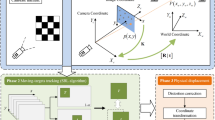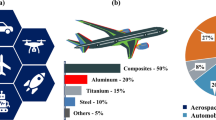Abstract
The Lamb wave phased array structural health monitoring method is effective in structural damage monitoring. In this method, the damage scattering signal can be obtained by comparing the damage structural response signal with health structural response signal, and it can be used for structural damage identification. But in the structural health monitoring based on wireless sensor networks, this method has some inevitable defects in data transmission. A large number of sampling data of damage response signal will cause huge wireless communication burden. To solve this problem, we proposed a phased array image method based on compressive sampling and data fusion for wireless structural damage monitoring. First, compressive sampling signal by compressive sampling method was collected. Then, data fusion for multi-sensor’s damage response signal was implemented in phased array. Finally, the Lamb wave phased array damage identification method based on compressive sampling and data fusion was proposed. Experimental results on carbon composite structure show that the proposed method can largely save network bandwidth and energy. This method can also realize the damage identification accurately on the aviation aluminum plate and keep the detection error within 0.82 mm.













Similar content being viewed by others
References
Sohn S (2016) Feasibility study on the use of wireless accelerometers in the experimental modal testing. J Supercomput 72(7):2848–2859
De Oliveira MA, Filho JV (2012) Structural health monitoring based on AR models and PZT sensors. IEEE Sens J 2012:1–4. doi:10.1109/ICSENS.2012.6411334
Ji S, Wang F, Guo P, Sun YJ, Wang J (2015) Compressive sampling based on wavelet analysis for lamb wave signals in wireless structural health monitoring. J Internet Technol 16(4):643–649
Engholm M, Stepinski T (2010) Adaptive beamforming for array imaging of plate structures using lamb waves. IEEE Trans Ultrason Ferroelectr Freq Control 57(12):2712–2724
Purekar AS, Pines DJ (2010) Damage detection in thin composite laminates using piezoelectric phased sensor arrays and guided Lamb wave interrogation. J Intell Mater Syst Struct 21(10):995–1010
Yuan SF, Wang Z, Qiu L et al (2013) A multi-radio sink node designed for wireless SHM applications. Smart Struct Syst 11(3):261–282
Wu J, Yuan SF, Ji S, Zhou GY, Wang Y, Wang ZL (2010) Multi-agent system design and evaluation for collaborative wireless sensor network in large structure health monitoring. Expert Syst Appl 37(3):2028–2036
Zhang Y, Li J (2006) Wavelet-based vibration sensor data compression technique for civil infrastructure condition monitoring. J Comput Civil Eng 20(6):390–399
Zhang Y, Li J (2006) Efficient seismic response data storage and transmission using ARX model-based sensor data compression algorithm. Earthq Eng Struct Dyn 35(6):781–788
Chintalapudi KK (2006) Design of wireless sensor network based structural health monitoring systems[D]. Univ. of Southern California, Los Angeles
Zhang YF, Li J (2007) Linear predietor-based lossless compression of vibration sensor data: systems approach. J Eng Mech ASCE 133(4):431–441
Jian S, Tan HW, Wang J, Wang JW, Lee SY (2015) A novel routing protocol providing good transmission reliability in underwater sensor networks. J Internet Ttechnol 16(1):171–178
Dong MX, Ota KR, Lin M (2014) UAV-assisted data gathering in wireless sensor networks. J Supercomput 70(3):1142–1155
Ren YJ, Shen J, Wang J, Han J, Lee SY (2015) Mutual verifiable provable data auditing in public cloud storage. J Internet Ttechnol 16(2):317–323
Xie SD, Wang YX (2014) Construction of tree network with limited delivery latency in homogeneous wireless sensor networks. Wirel Pers Commun 78(78):231–246
Donoho D (2006) Compressed sensing. IEEE Trans Inf Theory 52(4):1289–1306
Candes E (2006) Compressive sampling. Proceedings of International Congress of Mathematicians. European Mathematical Society Publishing House, Madrid, pp 1433–1452
Masoum A, Meratnia N, Havinga PJM (2013) A distributed compressive sensing technique for data gathering in wireless sensor networks. In: 4th International Conference on Emerging Ubiquitous Systems and Pervasive Networks, Ontario, 21–24 October 2013, pp 207–216
Ma J, Hussaini MY (2011) Extensions of compressed imaging: flying sensor, coded mask, and fast decoding. IEEE Trans Instrum Meas 60(9):3128–3139
Chengli S, Qi Z, Minghua W (2014) A novel speech enhancement method based on constrained low-rank and sparse matrix decomposition. Speech Commun 60(5):44–55
Huang Y, Beck JL, Wu S et al (2011) Robust diagnostics for bayesian compressive sensing technique in structural health monitoring. Struct Health Monit 7(1):103–110
Mascarenas D, Hush D, Theiler J, et al (2011) The application of compressed sensing to detecting damage in structures. In: The 8th International Workshop on Structural Health Monitoring. Stanford University, Stanford
O’Connor SM, Lynch JP, Gilbert AC (2011) Compressive sensing approach for structural health monitoring of ship hulls. In: The 8th International Workshop on Structural Health Monitoring. Stanford University, Stanford
Zou Z, Bao Y, Li H, Spencer B, Ou J (2014) Embedding compressive sensing based data loss recovery algorithm into wireless smart sensors for structural health monitoring. IEEE Sens J 15(2):797–808
Morlier J, Bettebghor D (2012) Compressed sensing applied to mode shapes reconstruction. IMAC Conference and Exposition on Structural Dynamics. Jacksonville, USA
Ji S, Sun YJ, Shen J (2014) A method of data recovery based on compressive sensing in wireless structural health monitoring. Math Prob Eng 2014. doi:10.1155/2014/546478
Sun YJ, Zhang YH, Qian CS, Zhang ZJ (2013) Near-field ultrasonic phased array deflection focusing based CFRP wing box structural health monitoring. Int J Distrib Sens Netw 4:1–6
Ji S, Wang F, Liu WJ, Yuan XM (2015) Twice-Hadamard-CNOT attack on Li et al.’s fault-tolerant quantum private comparison and the improved scheme. Front Phys China 10(2):192–197
Candes E, Tao T (2007) Near optimal signal recovery from random projections: Universal encoding strategies. IEEE Trans Inf Theory 52(12):5406–5425
Candes E, Romberg J, Tao T (2006) Robust uncertainty principles: exact signal reconstruction from highly incomplete frequency information. IEEE Trans Inf Theory 52(2):489–509
Baraniuk RG (2007) Compressive sensing. IEEE Signal Proc Mag 24(4):118–121
Candes E, Romberg J, Tao T (2006) Stable signal recovery from incomplete and inaccurate measurements. Commun Pure Appl Math 59(8):410–412
Dai QH, Fu CJ, Ji XY (2011) Research on compressed sensing. Chin J Comput 34(3):425–434
Fang H, Yang HR (2011) Greedy algorithms and compressed sensing. Chin Acta Autom Sin 37(12):1413–1421
Theis FJ, Jung A, Puntonet CG, et al (2007) Signal recovery from partial information via orthogonal matching pursuit. IEEE Trans Inf Theory April. dharmpal Takhar Jason. 15(2):419-439
Candes E (2008) The restricted isometry property and its implications for compressed sensing. Comptes Rendus Math. 346(9–10):589–592
Foucart S, Lai M (2009) Sparsest solutions of underdetermined linear systems via Lq-minimization for 0 \(<\) q \(<\) 1. Appl Comput Harmon Anal 26(3):395–407
Cai T, Wang L, Xu GW (2010) Shifting inequality and recovery of sparse signals. IEEE Trans Signal Proces 58(3):1300–1308
Cai T, Wang L, Xu GW (2010) New bounds for restricted isometry constants. IEEE Trans Inf Theory 56(9):4388–4394
Mallat S, Zhang Z (1993) Matching pursuits with time-frequency dictionaries. IEEE Trans Signal Process 41(12):3397–3415
Needell D, Vershynin R (2010) Signal recovery from incomplete an inaccurate measurement via regularized orthogonal matching pursuit. IEEE J Select Topics Signal Process 4(2):310–316. doi:10.1109/JSTSP.2010.2042412
Donoho DL, Tsaig Y, Drori I, Starck JL (2012) Sparse solution of underdetermined linear equations by stagewise orthogonal matching pursuit. IEEE Trans Inf Theory 58(2):1094–1121
Chen SS, Donoho DL, Saunders MA (2001) Atomic decomposition by basis pursuit. SIAM J Sci Comput 58(1):33–61
Kim SJ, Koh K, Lustig M (2007) Gorinevsky: A method for large scale regularized least squares. IEEE J Select Topics Signal Process 4:606–617
Figueiredo MAT, Nowak RD, Wright SJ (2007) Gradient projection for sparse reconstruction: Application to compressed sensing and other inverse problems. IEEE J Select Topics Signal Process 1(4):586–598
Ji S, Xue Y, Carin L (2008) Bayesian compressive sensing. IEEE Trans Signal Process 56(6):2346–2356
Llinas J, Hall DL (1998) An introduction to multi-sensor data fusion. IEEE Int Symp Circuits Syst 6:537–540
Bar-Shalom Y (1981) On the track-to-track correlation problem. IEEE Trans Autom Control 26(2):571–572
Beugnon C, Singh T, Llinas J et al (2000) Adaptive track fusion in a multisensor environment. In: Proceedings of the Third International Conference on Information Fusion, TUC2/24-TUC22/31
Gao R, Wen YY, Zhao H (2015) Secure data fusion in wireless multimedia sensor networks via compressed sensing. J Sens 636297
Fuzeng C (1995) Mathematical methods of multi-sensor data fusion. Chin Math Pract Theory 2:11–15
Heinzelman WR, Chandrakasan A, Balakrishnan H (2000) Energy efficient communication protocol for wireless micro sensor networks. Proceedings of 33rd Annual Hawaii International Conference on System Sciences. Hawaii, USA, pp 3005–3014
Acknowledgements
This work was supported by the National Natural Science Foundation of China (61672290, 61402234, 51505234, 51305211), Six talent peaks project in Jiangsu Province (XYDXXJS-040) and by the PAPD. Professor Jin Wang is the corresponding author.
Author information
Authors and Affiliations
Corresponding author
Rights and permissions
About this article
Cite this article
Ji, S., Tan, C., Yang, P. et al. Compressive sampling and data fusion-based structural damage monitoring in wireless sensor network. J Supercomput 74, 1108–1131 (2018). https://doi.org/10.1007/s11227-016-1938-x
Published:
Issue Date:
DOI: https://doi.org/10.1007/s11227-016-1938-x




